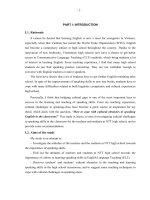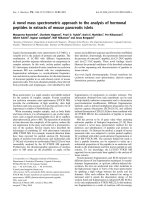Carry out cylinder compression test a compression test is used to check for mechanical faults related to the piston and combustion chamber
Bạn đang xem bản rút gọn của tài liệu. Xem và tải ngay bản đầy đủ của tài liệu tại đây (249.69 KB, 5 trang )
AUTOMOTIVE TECHNICIAN TRAINING – © TOM DENTON
Carry Out Cylinder Compression Test A compression test is used to check for
mechanical faults related to the piston and combustion chamber. Loss of compression
pressure can be caused by valves problems, piston faults and piston ring wear or
damage. In addition, cylinder bore wear and poor engine aspiration can reduce
compression pressures.
Compression is
important
Wet Test
A wet compression test is where a small drop of clean engine oil is pumped into the
cylinder to help seal the piston to the cylinder wall. During a compression test, this gives an indication of
where the loss of pressure is occurring. If pressure is lost via the valves, the observed pressure during the
wet test are the same as a dry test. If leakage is past the piston, the wet test will show increased
pressures during the test.
Engine Aspiration Engine aspiration relates to the flow of air through the engine
as the engine operating cycle executes. Incorrect valve timing and reduced valve
lift due to worn cams will show as low compression pressures on the worn
cylinders. Also, a blocked air cleaner or exhaust will reduce the compression
pressure readings on all cylinders.
We all have aspirations…
Check for the Specified Tolerance Note that the results
measured for each cylinder do not exceed the specified tolerance
between cylinders which is usually about 15 to 20 psi or 1 to 1.3
bar. Also note that low pressure readings, below 70 psi or 5 bar,
usually indicate valve defects. If the readings above these levels,
this may indicate piston ring wear or even early signs of valve
wear. It is important to check the valve clearances if low readings
are found, then re-test and check results.
Check each cylinder
Carry Out Cylinder Leakage Test This test is good alternative to the compression
test and allows the user to establish exactly where the leakage is occurring from
by listening for it. Pressurised air is applied into the cylinder when the piston is a
TDC at the end of the compression stroke. The rate of air pressure drop is
measured by time and pressure drop to indicate if the engine condition is
satisfactory. The source of a rapid loss of pressure can be established by listening
for the air loss. Listen carefully for air in the exhaust for exhaust valve defects, in
the air intake duct or carburettor for inlet valve defects and in the rocker cover or
from the dip stick tube for piston blow-by loss.
Leakage tester
Carry Out Engine Vacuum Tests Note that It is important to check that the
ignition timing and the exhaust gas constituents are correct before carrying out
manifold vacuum tests. Follow the engine manufacturer's instructions for
appropriate connection of the vacuum gauge.
Vacuum pump and gauge
Engine Speeds
Carry out a series of tests at cranking speed, idle speed, on acceleration and engine
overrun at about 2500 rpm.
Test Results Record the results obtained and compare them with manufacturer data and diagnostic
tables in order to be able to correctly interpret the results. Vacuum test readings should be appended
with results gained from other diagnostic tests; they should not be used in isolation to diagnosis engine
faults.
Vacuum Gauge and Pump Unit The vacuum gauge is generally connected with a flexible hose to the inlet
manifold where it is measures the absolute pressure (or vacuum) in the inlet manifold during the various
different phases of engine operation. Vacuum gauge readings are a measure of the effectiveness of
engine breathing and give an indication of volumetric efficiency. Note also that engine manifold pressure
(vacuum) is directly related to torque in a petrol engine (i.e. low pressure equals low torque due to
throttling of the engine). Mechanical, air supply and exhaust system, fuel system and ignition system
faults can be diagnosed from vacuum gauge readings.
Vacuum and Pressure Pump and Gauge Vacuum can measured in inches or millimetres of mercury or in
the SI unit of Kilopascals (kPa). Two series of tests can be made, one with the engine cranking, the other
with the engine running. During cranking, a fluctuation of the needle occurs as the pressure pulses in the
manifold occur at low frequency. If the needle swing is irregular, this could indicate a problem with one
or more of the cylinders. This would then need a leakage or compression test to positively identify.
Vacuum Readings During engine running tests, small oscillations of the needle
are normal. A vacuum of at least 16 in. of Hg (400mm of Hg) is acceptable.
Readings between 15 and 20 in. of Hg (400 to 550 mm of Hg; 50 to 65 kPa) are
normal with 4 cylinder engines being at the lower end and 8 and 12 cylinder
engines at the top end. The vacuum readings will fall by approximately 1 in. (25
mm) for each 330 metre (1000 ft) above sea level.
Cranking Test This test is not appropriate for engines fitted with catalytic
converters and for modern engines equipped with sophisticated emission control
systems where the inlet manifold has many vacuum connections. When the test
can be carried out, it can indicate certain mechanical faults. Disconnect the coil
negative terminal and fuel injectors in accordance with the manufacturer's
instructions to prevent the engine firing and blank off any vacuum pipes.
50
Scales vary
Ignition and fuel connections
AUTOMOTIVE TECHNICIAN TRAINING – © TOM DENTON
Cranking Vacuum The engine vacuum at cranking speeds should be between 10 and 20 in. of Hg and will
fall to zero when cranking is stopped. If vacuum connections cannot be blanked off, then lower readings
of about 4 in. of Hg. or less maybe normal.
PCV System Where problems with the PCV system are suspected, clamp the rubber pipes. In theory, this
should give higher readings assuming the pipes are clear. If no change occurs then the pipes are blocked
and further investigation is needed. Cleaning or replacing the PCV valve, oil strainer, air cleaner and
pipes, could correct the readings. If it does not, check and if necessary rectify, the inlet manifold gasket
sealing, brake servo and non return valve, other vacuum operated units, valve guides and sticking valves,
worn cam lobes or incorrect valve timing.
Engine Running Tests at Idle Speeds
Low vacuum readings can indicate problems that affect the
whole engine. This could mean problems with the valve or ignition timing, fuel mixture, manifold gasket
leaks or, wear of all cylinders and piston rings. A rapidly oscillating needle on the gauge can indicate
defects in individual cylinders. This could be valve seating, piston ring or cylinder wall wear. Normally
these problems would be associated with an engine misfire and in this case, further tests would be
needed in order to clearly identify the faulty cylinder.
Engine Running Tests with Sharp Acceleration and Deceleration from Idle
Quickly open and then close the throttle (tip in then out). The vacuum should
initially drop to about 2 to 3 in. of Hg (50 to 75 mm of Hg) and then climb to a
figure 5 to 7 inches (125 to 175 mm) above the idle reading during engines
overrun deceleration.
Acceleration test
Engine Running Tests at 2,500 Rpm
Compare the reading under this condition with the idle speed
reading. It should be slightly higher and the needle should be steady.
Compare Readings Maintain the engine speed for about a minute and observe the reading. If the figure
falls slightly this could indicate the possibility of a blocked or choked exhaust. Monitor the gauge
readings on deceleration and compare these with the deceleration to idle results from the sharp
acceleration test. Both sets of results should show similar trends, lower readings support the diagnosis of
a blocked exhaust.
Vacuum Readings The diagrams shown of vacuum
readings illustrate some faults that can be detected with
a vacuum gauge. Note that any diagnosis made with a
vacuum gauge should be supported by other diagnostic
tests carried out with alternative, additional instruments.
This is necessary before a final decision can be taken on
the cause and effect of a problem.
3
Look back over the previous section and write out a list of the key bullet points here:









